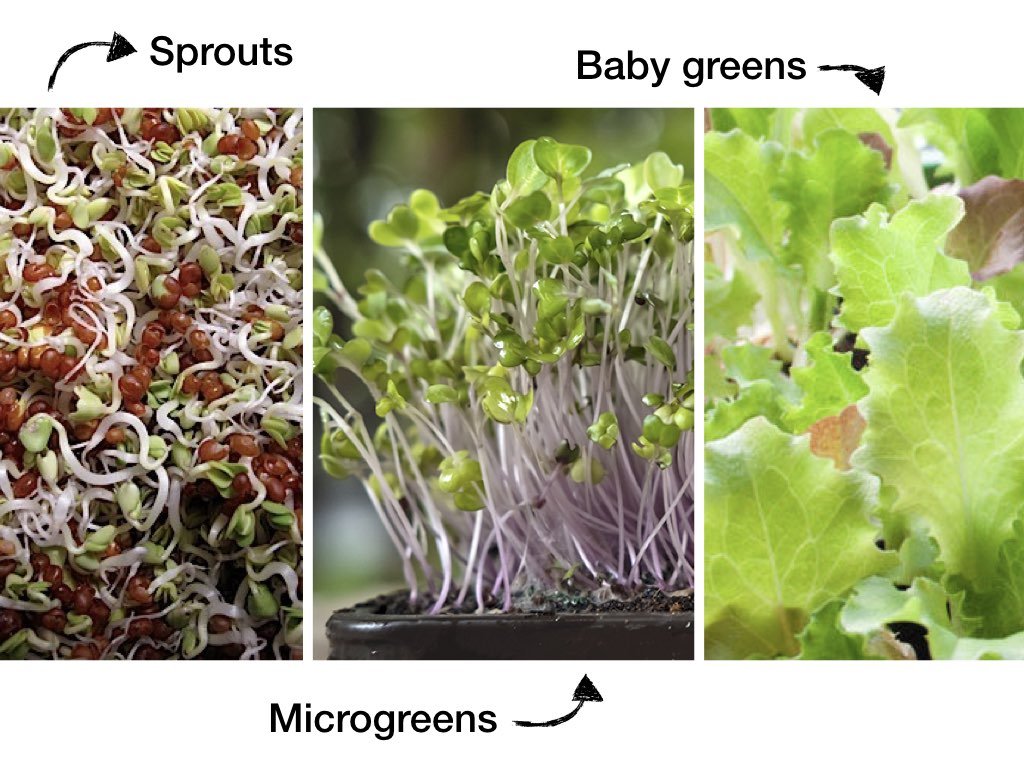IN THIS LESSON
Microgreens Basics: Why & What Microgreens are good for you?
Not only Microgreens are good for you but even your kids will love it! You'll be amazed how excited they are to eat these fun little Vegs – and no torture needed! So let's find out what they are!
If you've never done gardening before, or don't have a garden, this is a great first step. If you already grow Vegs, you'll find this is a good way to vary your diet, in particular during the last months of the winter – although I grow Microgreens throughout the year!
Growing Microgreens only requires minimum time, efforts & costs, producing super healthy food; and it grows just about anywhere, throughout the year.
What are Microgreens?
Here an example of pea shoots Microgreens.
What are Microgreens?
Microgreens are mostly grown throughout the year indoor to better control the environment, and only need light and minimum efforts! As a result you get Vegs grown at home, 100% local, no food miles and you know exactly what has gone into your food!
Because they are eaten at such an early stage, Microgreens are packed with flavours, colours and all the stuff that's good for you. And it's ready to eat in such a short time!
Explore the most complete, definitive list of Microgreens to grow!
Why the recent interest in Microgreens
Are Microgreens in demand?
See the interest over time on Google Trends for Microgreens – Worldwide, 2004 – present
In 2020, for the first time in 75 years, Western countries experienced the weaknesses of the food system we've allowed to develop and rely on, and people started to remember the importance of growing Vegs that are nutritious but also good for your immune system.
Not only delicious, it only takes a few minutes from harvest to landing in your plate and that means Microgreens bring you maximum nutrients, anti-oxydants, minerals and vitamins; up to 40 times more than when fully grown Vegs; and that means Microgreens are good for your health!
Microgreens vs …
picture credits MicroVeggy
FAQs
-
Let's define Sprouts first: Sprouts are plants that have just germinated and sprouted their hypocotyl and are eaten with the root attached.
Microgreens are harvested once their cotyledons are fully developed or at the first true leaf stage.
Microgreens vs Sprouts: So No, Microgreens aren't Sprouts! – and Microgreens wins: more colours, more tastes, more nutrients (and just a few days slower to grow)
-
Let's define Baby Greens first: this would be the stage the plants develop to, if left to grow in the growing media for 4-8 weeks past the Microgreens stage. They will look the same as the fully grown Veg, just tender and baby size!
Microgreens vs Baby Greens: So No, Microgreens aren't Baby Greens!
-
Let's define Leafy Greens first: past the Baby Greens stage, leafy vegetables, also called Leafy Greens, salad greens, pot herbs, vegetable greens, or simply greens, are fully grown plant leaves eaten as a vegetable.
Microgreens won't grow (well) as fully grown vegs because of the seeding density and lack of grow media and nutrients it will need to reach full growth.
-
Sprouts are less colourful, less nutritious than Microgreens with less fiber content. Given how they are grown, raw sprouts can also be riskier to eat.
-
The best herbs for microgreens are ones that germinate reliably, quickly and have a lot of flavors in their leaves: try Lemon Grass, Parsley, Coriander (Love!), Basil, Borage, Cilantro.
-
It's an easy one to grow and full of nutrients (I also grow Watercress in my Aquaponics Smart Greenhouse), cress and watercress even beat Kale as shown in USDA research!
See the full list of Microgreens to grow!
-
Growing Microgreens hydroponically is just one of the methods for growing Microgreens, without soil. It is easier to control, cleaner and easier! The Microgreens will only use their own energy stored in the seed, water and oxygen.
Read more about why it's a good idea to grow Microgreens without soil, in a pure way.




